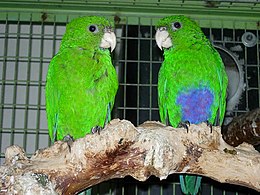Blue-bellied parrot
| Blue-bellied parrot | |
|---|---|

| |
| male right, female left | |
| Scientific classification | |
| Domain: | Eukaryota |
| Kingdom: | Animalia |
| Phylum: | Chordata |
| Class: | Aves |
| Order: | Psittaciformes |
| Family: | Psittacidae |
| Tribe: | Androglossini |
| Genus: | Triclaria Wagler,1832 |
| Species: | T. malachitacea
|
| Binomial name | |
| Triclaria malachitacea (Spix,1824)
| |

| |
Theblue-bellied parrotorpurple-bellied parrot(Triclaria malachitacea) is the onlyspeciesin itsgenus.It is generally consideredendemicto the humidAtlantic Forestof southeasternBrazil,but there are two unconfirmed records fromMisionesinArgentina.It occurs up to 1000 m. (3300 ft).
It is a relatively long-tailedparrotwith a total length of c. 28 cm. (11 in). It is green overall and the beak is whitish. Only the male has the bluish-purple patch on the belly for which thisspeciesis named. It has a whistled call and pairs will sing in duet, but it is typically fairly quiet and therefore easily overlooked.
It has been recorded feeding onseeds,fruits,flowerbuds,nectarand someinsects.Thenestis placed in the cavity of a large tree or palm. It nests between September (October inRio Grande do Sul) and January. The pair is highlyterritorialduring the breeding season.
Much of the originalforest coverin its range has been removed in favour of cultivated crops liketobaccoandbananas.Now mostly restricted to remnant forest strips on slopes and ridges, which cover far less than 10% of the original range. Previously, it was believed that 5,000–10,000 birds survived, but recent evidence suggests that c. 10,000 survive in the state of Rio Grande do Sul alone. Significant populations also exists in the states ofRio de JaneiroandSão Paulo,butpopulation estimatesfor these are not available. Regardless, numbers are dwindling throughout its range due to further habitat changes. The cage-bird trade is not considered a major threat at this point, as only a small number are captured for the local market, but nevertheless fair numbers reached theNetherlandsin the 1970-1980s. It occurs in 14 protected areas.
References
[edit]- ^BirdLife International (2022)."Triclaria malachitacea".IUCN Red List of Threatened Species.2022:e.T22686419A209540315.Retrieved29 July2022.
- Juniper, T., & M. Parr. (2003).A Guide to the Parrots of the World.Pica Press.ISBN0-7136-6933-0
- Blue-bellied parrotmedia fromARKive.Accessed on January 14, 2008.
External links
[edit] Media related toTriclaria malachitaceaat Wikimedia Commons
Media related toTriclaria malachitaceaat Wikimedia Commons Data related toTriclaria malachitaceaat Wikispecies
Data related toTriclaria malachitaceaat Wikispecies

